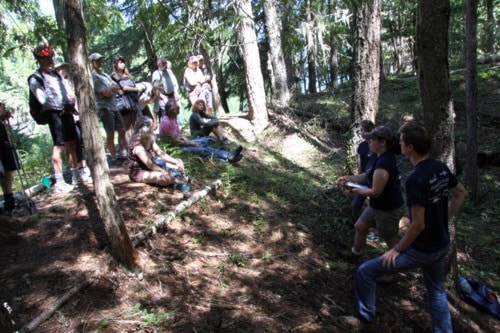LEMON CREEK — An archaeology field school expects to know by summer’s end just how old a series of Slocan Valley pithouses are.
Students led by anthropology professor Dr. Nathan Goodale of Hamilton College in New York state have spent the last several weeks sifting through dirt at the site known as the Slocan Narrows Village, looking for bits of charcoal that will provide clues.
They shared their findings Sunday with a large number of locals at an open house.
Goodale says about 35 pithouses were concentrated at the narrows on both sides of the river, while nearly 90 existed within a 2 km radius, suggesting a relatively large population. Deep depressions still exist at most of these sites, although others have eroded away, and a few are now completely underwater. Goodale describes it all as “really significant.”
“It is one of the last remaining villages of this size,” he told visitors. “We have a lot to learn from it.”
Radiocarbon dating — based on the decay of radioactive isotopes — suggests the village was occupied intermittently beginning 3,000 years ago, and as recently as 200 years ago — about the time of European contact with local First Nations.
“By the end of the summer we’ll have probably all of the houses dated,” Goodale says. “We’ll know how the village formed and fluctuated through time.”
In at least one case, it appears a pithouse was occupied twice — at points 1,000 years apart.
Another house is among the largest known in BC and the Pacific Northwest at 23 metres in diameter. It’s also the oldest of its size group at 2,700 years, predating all others by a millennium.
The houses were typically burned when abandoned, so it is the charcoal remains of wooden roof beams and support posts students seek as they excavate 50 x 50 cm patches. They’ve had success, although sometimes it requires more than a meter of digging.

The housepits themselves were dome-shaped permanent dwellings entered through the top on a notched ladder. They had a hearth in the centre, and were quite warm in winter. The Sinixt First Nation and their ancestors mainly occupied them in the fall through spring.
Goodale says they likely congregated here because the narrows was easily crossed by boat and had a great vantage point to observe anyone coming down river.
In addition to charcoal, stone tools have been found at the village, including arrowheads, scrapers, and ground stones, which further help date the deposits.
The excavation of one pit also revealed a large number of bones, most of which were beaver digits, suggesting it was the site of hide processing some 1,800 years ago. Other bones have been located of deer and muskrat as well as turtle and mussel shells.
Another site poses a mystery: a series of crescent-shaped depressions that at first appeared to be partly destroyed housepits might be something else entirely.
They have been carbon dated to about 250 years ago, resulting in two possible theories: they may be defensive earthworks — a place to lay low while watching the river — or they could be the by-product of nearby railway construction, which disturbed ancient tools and charcoal.
The Slocan Narrows was first surveyed by Gordon Mohs in the 1970s, and again in 2000 while Goodale was a graduate student at the University of Montana.
After plying his trade in the Middle East and Ireland and completing a PhD, Goodale joined the faculty at Hamilton College and in 2009 brought his first group of students to the Slocan.
This time he’s working in partnership with Selkirk College, and has received funding from the Columbia Basin Trust through the Slocan Valley Heritage Trail Society.
Goodale says his goals are to document the archaeology of First Nations in the Slocan Valley, help preserve cultural heritage, and educate students and local residents about the area’s history and prehistory.
Archaeology boot camp
Field schools like the one at Slocan Narrows are requirements for archaeologists in training.
“You have to do one of these schools before you can get a job,” says Dr. Nathan Goodale, a professor at Hamilton College in central New York, who began bringing students here two years ago.
He has since partnered with Selkirk College to involve their students as well.
“They learn how to excavate and use technology associated with archaeology but also that you have to work with people,” Goodale explains. “They have to work in confined spaces with each other for a long time.”
For the past seven weeks, students have been without laptops or cellphones. They get half an hour each week to email their families.
“We take them out of their comfort zone and give them an experience not a lot of us get anymore,” Goodale says.
